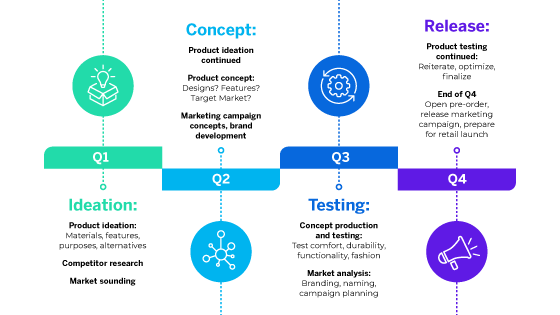While business owners might think their newest product is the latest in innovation, it’s an unfortunate reality that competition continues to be stiff, with approximately 30,000 products launched every year.
With thousands of products to compete with, it’s vital for companies to understand how to market their products to boost sales, improve branding, and gain a loyal customer following.
Product marketing is just one of the many ways marketers can influence the buyer’s journey and turn leads into sales. But how do you market a product?
This article highlights some of the key takeaways from product marketing and what you can do to ensure your newest products and services don’t go unnoticed.
- What Is Product Marketing?
- Designing a Product Marketing Strategy
- How to Create an Effective Product Launch Plan in 5 Steps
- Developing a Product Marketing Strategy That Wins
Download this post by entering your email below
What Is Product Marketing?
Product marketing is, in essence, marketing your product to specific audiences to ensure higher demand, better sales, and better brand preference. Even if your company sells only one or two products, it’s crucial to engage in product marketing from the early stages of development to your product’s release.
Product marketing shouldn’t be confused with regular marketing, although many entrepreneurs make this mistake from the get-go.
While regular marketing efforts are all-inclusive of your brand, values, and products, product marketing is set specifically for a targeted audience.
For instance, imagine the thousands of furniture pieces at IKEA, one of the most successful furniture manufacturers and sellers in the world.
While IKEA promotes its products as green, affordable, and convenient, how does it sell specific products, such as its crib sets or beds? Therein lies the problem with regular marketing.
Go-To-Market Strategy
A unique approach is needed for every single product. As a marketer, it’s vital for your business to implement a product marketing strategy that combines regular conventional marketing, sales, and product design in its development.
Lead generation shouldn’t be put on the back burner, especially not when it comes to product marketing.
While you might think your product will sell itself, conventional marketing (such as email campaigns, PR activities, and targeted ads) is a great way to reach potential customers and build brand awareness.
Work with your sales team to develop a product marketing plan that continues to market to your existing customers as well as to new ones.
![The Ultimate Guide to a Successful Go-to-Market Strategy [+Examples] | Catalant](https://catalant.com/wp-content/uploads/2022/07/Screen-Shot-2022-07-08-at-9.43.11-AM-1024x963.png)
Designing a Product Marketing Strategy
Knowing how to market a product might seem impossible, but it doesn’t have to be. Below are some key steps you can take to ensure your product marketing strategy is successful and leads to better sales.
Do thorough market research and know your audience
So you have a great idea for a product. But, who is this great idea for? Are your customer pain points being addressed in its design? Does your product offer a solution to their pain points?
These are all vital questions you and your team need to ask yourselves before launching your product. Take the time to do high-quality and thorough market research that addresses:
- What your customers want
- Their pain points
- Your competitors
And the overall trends across your industry will give you valuable insights into how to design and market your product.
Remember, you’re offering a solution to your clients, even your existing customers, and selling it for a price. There’s no better way to start market research than with your own customers and by keeping an eye on the competition.
Plan your product launch
When we say you need to be obsessed with every detail of your product launch, we mean it.
The pre-launch market research phase should only be the tip of the iceberg when it comes to launching a successful and high-demand product. During the launch phase, you’ll also want to consider marketing to your target audience through various channels.
From social media to webinars and seminars, it’s important to know how to promote your products so they don’t go unnoticed.
At the same time, ensure that your website is up and running with landing pages ready for customers to purchase from you, as well as content-rich descriptions of your product. Creating compelling visuals and videos is also a great way to grab attention and build interest.
Lastly, plan your post-launch by setting milestones and deadlines to measure success.
It’s important that you are able to track the progress of your product launch so that you can make quick adaptations if needed. How will this post-launch phase look for your team? Will they use data analytics or customer feedback to make adjustments?
Planning your post-launch and having a team ready to measure customer satisfaction is also key in rebranding and possibly relaunching your product for better success.

Develop an effective content marketing strategy
One of the key elements of product marketing lies in content creation.
Great content can help you inform, educate, and build trust with customers who are interested in learning more about your products and services. Content such as blog posts, videos, webinars, case studies, e-books, and white papers should all be included in your product marketing strategy.
Don’t believe content marketing is that big a deal? New statistics show that over 80% of people purchase a product or service as a result of content marketing.
Considering how cost-effective content marketing is and how easy it can be to implement on your websites, social media pages, and other platforms, it would be a mistake not to develop a content marketing strategy for your product!
How to Create an Effective Product Launch Plan in 5 Steps
Having a perfect product is only the first step. Before you can successfully launch it, you need a comprehensive plan of action. Without this roadmap, you can lose momentum and struggle to catch up, even if your product is superior to the competition. So, here are the steps involved to create an effective product launch plan.
Step 1: Determine your launch goals
Yes, your primary goal may be to sell as many products as possible. However, you must come up with quantifiable and realistic goals for your launch. Also, it’s critical to set deadlines for these objectives, so you can tell if you’re on track or not.
Some examples of product launch goals can include:
- Awareness – Try to get a specific number of new subscribers or site visitors.
- Sales – Base your sales numbers on actual projections, not what you hope to bring in.
- Promotions – Maybe you can send out invites or discounts before launch day. How many of these discounts do you want to get back initially?
- Referrals – Set up a referral program to boost sales as more people use and love your product.
Step 2: Incorporate your market research
Market research is essential for launching a product as it tells you whether you’re on track to succeed. When developing your launch plan, make sure to create customer avatars and compile the research into organized groups. This way, you know how to promote your new product to these groups before, during, and after the launch.
The main elements to include within this research are:
- Who will want to buy this product?
- Where can I reach my target audience?
- How soon will my audience want to buy this product?
- What is the competition for this product? Will my competitors affect my launch sales?
Step 3: Validate your product
One of the main reasons why so many products fail is that businesses don’t validate them before launching. At first, it may seem counterintuitive to validate a product that doesn’t technically exist, but there are ways to do this pre-launch.
For example, you can survey your target demographic to see if your product is something they want or need. Ask questions like, “If the product were available today, would you buy it?” These responses will provide valuable insight.
Another validation method is to pre-sell your product. If it’s desirable enough, customers will jump at the chance to pay for it, even if they have to wait for the launch. Plus, you can use pre-sales to boost your launch budget.
Step 4: Create a timeline
Product launches have three distinct phases: pre-launch, launch, and post-launch. Each of these phases will have specific steps, so it’s critical to list them in chronological order.
Typically, pre-launch tasks include things, such as product testing, revisions, and pre-sales. You don’t want to launch a product before it’s ready, so testing and re-testing is crucial.
During the launch, you want to make sure you promote the product on all your target channels to reach your desired demographics. There should be a checklist of different marketing messages, links, and landing pages to distribute during this phase.
Finally, the post-launch phase is where you analyze your results and adjust your strategy accordingly. For example, if some landing pages are converting better than others, you may cut the ones that aren’t working. Similarly, you may discover that your product resonates with a different audience than you expected.
Step 5: Finalize your budget
Launching a product usually involves a lot of marketing and promotion, so you have to have a budget in mind. This budget can cover things like product distribution, paid ads, demonstrations, and more. Make sure to set a realistic budget that won’t cannibalize your launch sales too much.
That said, during the initial phase of a product launch, your earnings may only pay for your marketing budget. However, once you have momentum going, you can cut down on promotional materials and focus more on profitability.
Developing a Product Marketing Strategy That Wins
If you plan on launching a product soon, consider the steps above to ensure you implement fresh techniques in your overall marketing plan.
In addition, to truly elevate your product marketing strategy, it’s vital to collaborate with top-tier content creators and strategists. WriterAccess is home to a diverse array of over 15,000 professionals, including skilled writers, designers, and, importantly, seasoned marketing strategists. These experts are adept at crafting strategies that bridge the gap between creative content and market demands, ensuring your product launch is successful from concept to execution.
Enlist the expertise of our dedicated strategists at WriterAccess who can guide your product marketing strategies with precision and innovation. Get started with your free 14-day trial today and transform your product launch into a market sensation!








